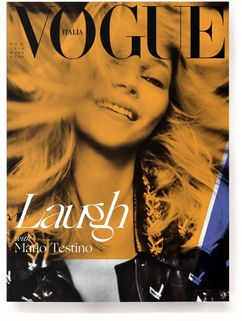

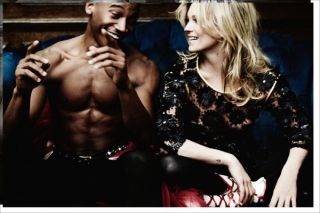
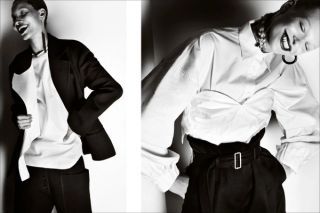
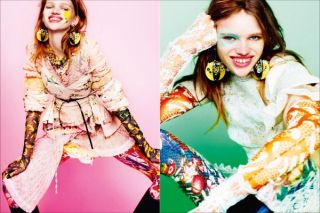

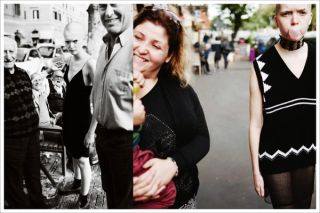
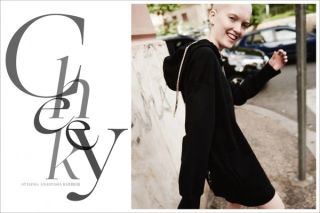
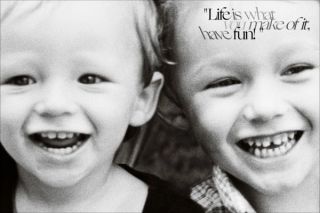
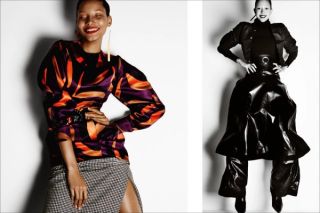

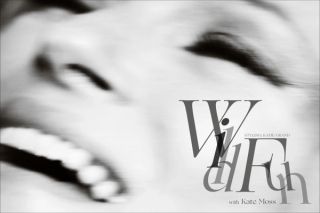
VOGUE ITALIA SPECIAL EDITION
Mario Testino was invited by Vogue Italia to guest edit the February 2016 issue. The special edition is dedicated to happiness and positivity with Testino photographing all five stories and Kate Moss featuring on the double gatefold cover.
MARIOTESTINO+ provided the art direction, graphic design and supporting films.
INTERVIEW WITH CARLO DUCCI
‘We often forget how innocent children are, their ability to laugh at everything, their light heartedness. When a child laughs, I can’t help looking at them. It’s something that happens with all of us, I’m sure.’ Mario Testino’s thoughts on the matter are clear. Our lives rush by, and we adults are submerged in the rules, concepts and conventions that mark the rhythm of our everyday existence: they may be imposed on us, or we may accept them freely, but they make us forget the joyful aspects of life, the things that give us peace of mind. ‘So I decided to fill this edition of Vogue Italia, a very special edition for me, with photos of laughing children. They’re the symbol of pure happiness.’ Images that emphasize the guiding theme of the whole issue, which opens with a mother called Kate Moss. ‘She’s the most sought-after model in the world, not the most beautiful. Above all she’s unique, for her innate, infectious, positive outlook. The lines on her face are laughter lines.’ Happiness, joy, a positive outlook – these things are the themes of this issue. And they’re a lifestyle choice. ‘Absolutely. This issue is a seed of happiness.’ A seed we have to care for and water, that gives us joy as we watch it grow: it’s a concept that’s been with us since Socrates and the dawn of philosophy, and today it’s at the core of positive psychology, a discipline whose aim is to increase happiness and optimism. ‘You give and you get,’ Testino confirms. ‘When we give happiness we can’t help getting happiness in return. That’s why I decided to include photos of children in this issue of Vogue Italia. And if it wasn’t for Franca Sozzani’s ability to grasp this spirit, the expressive freedom she extends to herself and to us, I couldn’t have done it.’
Mario Testino has a long-standing affinity with smiles. In the 1980s, when he was already a major figure in photography, the fashion gurus commented: ‘It’s his happy snappy shots that give Mario a special place in the fashion world.’ He laughs at the recollection: ‘I’ve always tried to take positive pictures, even if they weren’t always considered as cool or interesting. At the beginning of my career, Franca asked me to shoot some smiles for two magazines, Per Lui and Lei, that she directed at the time: they came out almost as grimaces, because like everyone else in those days I suffered from the prejudice that positive thinking wasn’t “fair”. I was fortunate: those images gained me recognition all over the world. Later, when I began working for Harper’s Bazaar, Fabien Baron said to me: “Your pictures are serious. But when you’re surrounded by people, you can make everyone laugh. Why don’t you bring that outlook to your work?” That was the second time someone made me think about the meaning of laughter.’ It’s a clear sense of serenity that informs the photographic opus of Mario Testino, and his projects for the future. His photos exude a propensity to happiness, the thing that guides him in his life and his work. ‘We all seem to be born with this idea that a serious or sad or even melancholy image is more powerful than a picture of a person laughing. It isn’t true. And the same goes for cinema: is drama really stronger than comedy? In reality, it’s more difficult to make a good comedy, because there’s always the risk of banality, and perhaps that’s why there aren’t more comedies.’ How do we manage to stay positive without lapsing into cliché? ‘We have to choose freedom, and not make do with the models imposed by others.
When I arrived in New York in the 1990s, everyone told me: “Your success is measured by how many limousines you own.” I was happy with any old car. I already had my own vision of life, and it was a long way from the vision others thought was right for me. I never gave in to them. The important thing is to follow your own path.’ It’s a personal philosophy which has success as a natural consequence. And it includes the ability to be amazed, an attitude that feeds enthusiasm for the here-and-now. ‘I’ve won so many awards. Now’s the moment to pay it back, to think about others. I’m more and more convinced of this, especially when I observe the people I meet, or read the comments of people who come to my exhibitions. Happiness is vital. And is viral. I have one million nine hundred thousand followers on Instagram, and it’s interesting to see what they write, the things that strike them. Happiness is an almost inescapable need.’
Mario and I are on the same wavelength. I too believe that, deep down, happiness is just a state of mind: being aware of this is a lifesaver in many situations, and indisputably helpful even in cases of objective difficulty. Is it a natural predisposition? An excess of positive thinking? Perhaps. But I can bear witness, with my limited but intense experience, that it’s worth trying. Even if only by surrounding ourselves with people who already think this way. People like Mario Testino. The fact is, he’s never had to try too hard. You just have to be there at one of his shoots: the atmosphere is light-hearted, people are making jokes. There’s no place for rigidity, heavy-handedness. Smiles come easy. ‘In this issue, the story of the “cheeky” girl shows how joy can take so many forms. In the innocence of children; in the “madness” of unprovoked laughter; in the consciousness that we’re doing what we want to do, regardless of whether it makes others uncomfortable.’ Happiness comes from being full, not empty: full of intelligence, insight, feeling, love.’
There was a time when we would have described people like Mario Testino as non-conformists. Now we simply call them free. ‘Exactly. You can make anything interesting with a smile: I’ve learned that in my thirty-five years of experience as a photographer. And it’s marvellous that I can dedicate an issue of Vogue Italia to positive thinking. Maybe that’s the real non-conformism?’
Testino has been invited to creative direct and photograph numerous special editions of Vogue magazine to date. Testino works closely with the respective editors of each title to develop a theme that will dictate everything inside the issue. With the support of his team at MARIOTESTINO+, he conceives a bespoke treatment to the art direction, applying conceptual typography and a unique layout appropriate to each theme. Themes have included Sex, The Body, Blondes and Obsession.





